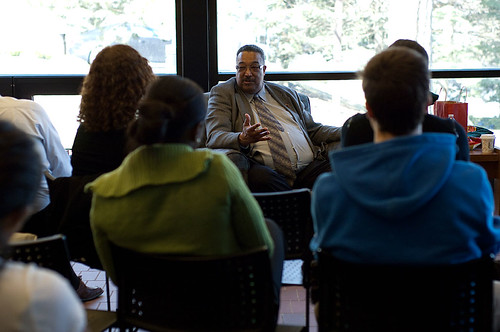For Gregory Threatte ’69 and Todd Brown ’71, the watershed events of the late 1960s that gave birth to ĐÂ°Ä˛ĘżŞ˝±˝áąű’s first cultural center remain indelible moments in their lives.
“This valley was transformative,” Threatte, trustee emeritus, told members of the campus community Friday during an impassioned discussion about the founding of the ALANA Cultural Center.
“The fact that we are in this room today talking about how far we come have in this journey is incredible,” added Brown, also a university trustee.
Days after the assassination of Martin Luther King Jr. in April 1968, the discomfort level on campus reached a tipping point, they explained, when a member of the Sigma Nu fraternity pointed a starter pistol at African-American students.
 |
| Todd Brown ’71 (right) shares a light moment with Gregory Threatte ’69 during a discussion about the founding of ALANA. (Photo by Janna Minehart ’13) |
With America in the throws of a social revolution, Threatte — one of three-dozen African-American students on campus — believed change could come from the ground up. So he gathered enough courage to stage an impromptu rally outside the student union.
“None of us had any idea where that day would lead us,” he said.
Minutes after the rally ended, Threatte recalled, nearly half the student body and faculty marched to the administration building, hundreds entering and refusing to leave until campus leaders took action.
“I turned my head around and there was a sea of people following me. I couldn’t believe how many people would support us.”
The historical impact of that day reached far beyond ĐÂ°Ä˛ĘżŞ˝±˝áąű.
Newspaper clippings from the late 1960s that hang on the walls of ALANA describe the event as one of the nation’s first sit-ins for black equality.
|
After a series of failed talks with administrators, more sit-ins ensued throughout the following year and ended with a 70-hour occupation of Merrill House in spring 1969.
Thanks to their persistence, the former buildings and ground office site was designated as ĐÂ°Ä˛ĘżŞ˝±˝áąű’s first cultural center. It moved into its new building in 1989.
“I remember sitting on the floor of the center for hours as some of the key figures in the civil rights movement visited,” said Brown, describing how he helped organize talks with Adam Clayton Powell ’30, Ralph Abernathy, and Muhammed Ali, among others.
“We were able attract folks of this caliber because we got noticeable attention for what we had done. People were interested in the actions of this small group of students in upstate New York.”
After graduating, Brown continued the work he had started years earlier. He was hired as the center’s second director, helping transform the venue from “a safe haven for African-American students” into a “thriving community venue for all people of diverse backgrounds.”
Threatte and Brown’s fight for racial equality didn’t only leave a mark on the campus community, but also gave them the conviction to achieve their own dreams.
“If it were not for the struggles that we endured, I would not be where I am today,” Threatte said.
“Here’s a guy who is the head of pathology at SUNY Upstate Medical University,” added Brown, a former Kraft Foods executive and recently retired bank president, pointing at Threatte. “In 1969, we never thought this could be possible.”
 |
| Gregory Threatte ’69 talks about the founding of ALANA. Threatte, a trustee emeritus, is chair of the department of pathology at SUNY Upstate Medical University. (Photo by Janna Minehart ’13) |